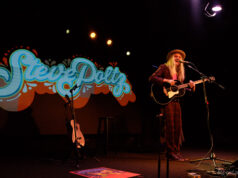Suzanne Vega is a master storyteller in addition being a fantastic singer and songwriter.
At The Birchmere recently, she wove a thread through the evening that went back decades to when she was 18 and working at a summer camp in the Adirondacks. That summer, she met a boy from Liverpool, England, who worked as the arts and crafts counselor for the boys’ camp down the road. They met at the bar that catered to the counselors at both camps and for the rest of the summer they “weren’t exactly dating. More like rolling around in a dirty field.”
At the end of the summer, when Suzanne was to go back to New York City and the boy was to return to England, she wrote the song “Gypsy” on an index card and gave it to him. In return, he gave her a bandana. Someone in the audience asked if she still had it, and she said she does.
But the story doesn’t end there. Years later, she was in that boy’s hometown, lying in bed at her hotel, reading The Three Musketeers, and listening to the church bells ring, wondering what had happened him. That was when she wrote “In Liverpool.”
The story has a great ending: Eventually, she saw that boy again, and he had heard the song “Gypsy” on the BBC. Vega’s mother also figured out what was up and asked her, “Does he still have a long, slender body?”
In the mid-late ’80s, after the release of her second album, Solitude Standing, Vega achieved a level of international stardom and recognition. Vega came out of the Fast Folk movement in New York, which also gave us Shawn Colvin (who sang backup for Vega before she released her first album). At the time, the singer-songwriter genre was moribund, having moved toward soft rock. Vega’s success and artistry opened the door for a number of “contemporary” singer-songwriters; in her just-released memoir, Don’t Tell Anybody The Secrets I Told You, Lucinda Williams writes about seeing Vega when she was living in New York in the late ’70s.
Vega still performs some of the hits from Solitude Standing. At The Birchmere on April 26, she closed the main set with “Tom’s Diner,” a slice of life the in the Big Apple, followed by her biggest hit, “Luka.” It’s an unusual song to have been a pop hit, as it tackles the subject of child abuse. The set also included the title track.
Watch the official music video for “Luka” by Suzanne Vega on YouTube:
The set went even deeper, into Vega’s first, self-titled LP, beginning with “Marlene On The Wall,” which is about the actress Marlene Dietrich. She mused on how she used to think “Marlene would tell me not to give it up so easily,” until she read her daughter’s biography and learned that she was “giving it away whenever she felt like it, which seems like much of the time.”
After “Small Blue Thing,” another track from that first album, Suzanne played “Caramel.” “I know that song’s not about dessert,” she said, but it makes her think of The Birchmere’s bread pudding. “The Queen and the Soldier,” another song from that first album, she described “as very long, very sad,” and “people seem fond of it.”
Vega also played tribute to some of her favorite songwriters. “When Heroes Goes Down,” she said, is a “fast song…usually 1:58.” It’s an homage to Elvis Costello, so she decided to put one of his songs, “Lipstick Vogue,” right in the middle of it.
For the first number of her encore, she did “a very New York song by a very New York songwriter,” Lou Reed’s “Walk On The Wild Side.” In all the times Vega saw Lou Reed perform over the years, she almost never saw Lou perform it — his attitude was, it’s a hit and everyone knows it. She added how he always did with a smirk and a bit of sarcasm, and she performs the song with more melancholy.
At a benefit for the people of the Ukraine, about a year ago, Suzanne played “Rock In His Pocket.” The song is about David and Goliath, from David’s point of view. She also shared a new song, “Last Train to Mariopol,” inspired by events in that country. The set also included “Some Journey” and the quirky “Left of Center,” something of an anthem for all of us who didn’t quite fit into the mainstream.
After “Walk On The Wild Side,” the encore turned back to Vega’s own material. The story behind “Tombstone” was incredible: When their 17-year-old cat died, her parents placed her in a box, put in in the East River and lit it on fire, sending her out to sea with a Viking funeral. This disturbed her, and she wrote “Tombstone” about how she’d really like to have a grave (and a grave marker). She ended the encore with “Rosemary.”
After more than 40 years of performing, Vega’s voice still sounds incredible; she’s a fantastic singer. Many artists would struggle to impress when playing in just duo — her accompanist played electric guitar, and she played acoustic for more of the songs. In this case, it just served to put Vega’s voice up in front, where it should be.
And you should be at the next Suzanne Vega show. Her appearance at The Birchmere sold out in a heartbeat, so grab your tickets where you can. Check out her website for tourdates!






